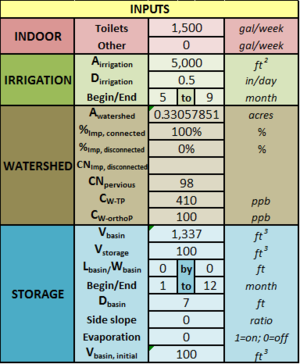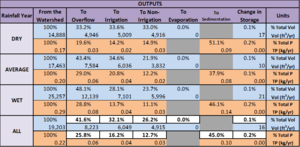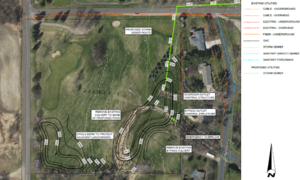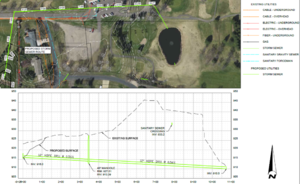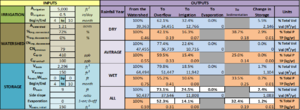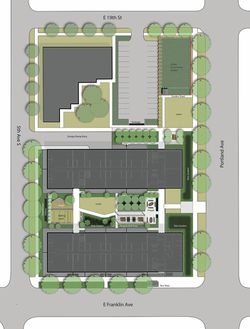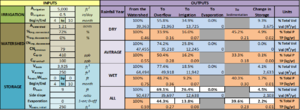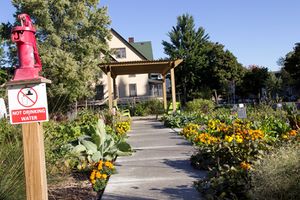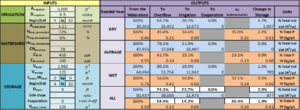
Determining the appropriate storage size for a stormwater and rainwater harvest and use/reuse system
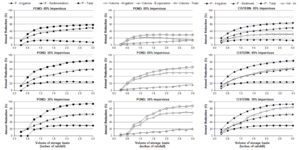
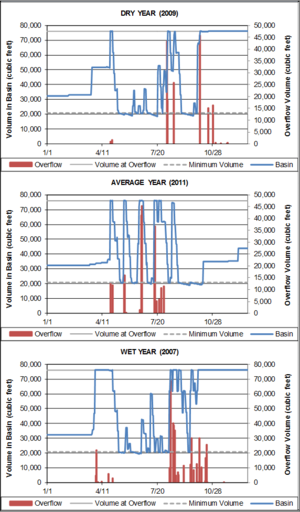
Decision-making on storage size can have a strong impact on the economic feasibility of stormwater harvesting (VA DCR, 2009). During the pre-design phase, a water balance should have been completed. This water balance should be refined during the Design Phase to incorporate other factors such as cost, site constraints, aesthetic concerns, or water quality criteria. For these reasons, the selection and sizing of storage units may be an iterative process. Work with an engineer, system supplier or accredited professional with experience using stormwater harvest and use calculators to appropriately size storage units for your stormwater harvest and use system.
Determining the appropriate storage size for a stormwater harvest and use system is an iterative process. The design is usually optimized when the storage unit size (that is to say, cost) is as low as possible while achieving all or an acceptable fraction of the volume or pollutant reduction goals for the site. The storage unit size is usually the primary cost component of a stormwater harvest and use system. If a storage unit is undersized, too much overflow will occur and the system will not achieve the volume and pollutant reduction goals. If a storage unit is oversized, the cost of the storage system will be unnecessarily high and reduce the overall cost-effectiveness of the system.
As you increase the size of a storage unit, the amount of volume and pollutant reduction will increase until the amount of storage begins to exceed demand. That is to say, the rate of increase in reduction benefit for each incremental increase in storage size gradually decreases until a maximum reduction benefit is reached for the system. At this point, no further increases in storage volume result in any additional reduction benefit for the system.
This “diminishing returns” characteristic was illustrated by a series of model runs completed as part of the development of the Minnehaha Creek Watershed District (MCWD) Stormwater Reuse Calculator. A total of 576 model iterations were run to test the sensitivity of sizing a stormwater storage tank. The performance of stormwater harvest and use system was assessed by analyzing the percent annual reduction in phosphorus and volume due to irrigation for a storage unit volume sized to capture rainfall events ranging from 0.25 inch to 3 inch for a range of generic site characteristics. See pages 61-64 of the 2013 Stormwater Harvesting: Accounting of Benefits and Feasibility report for more details on the model inputs. The graphs in the figure to the right show example results for a 1-acre watershed, 5-month growing season, and pervious CN of 74. Graphs illustrating all 576 model iterations are shown in Appendix B of the 2013 Stormwater Harvesting: Accounting of Benefits and Feasibility report.
It may be useful to start your design by sizing your storage unit to capture a certain size rainfall event from the site, such as a 0.5 inch or 1 inch rainfall event. Then you can decrease or increase your storage unit volume until you maximize the cost-benefit (reduction achieved per cost of the storage unit). But in general, you should estimate the reduction benefit of a range of storage volumes to understand how sensitive the stormwater harvest and use system is to changes in storage volume.
In the design of the storage unit, it is also important to utilize a daily time-step model that generates outputs on a daily time-step to account for other design considerations, such as limiting overflow events or minimizing pond surface level changes. For example, the figure to the right illustrates the water level changes in the same stormwater harvest and use system over a characteristic dry (2009), average (2007), and wet (2011) year. In the dry year, the basin level (blue line) is at the minimum water level (dashed grey line) for most of the growing season with several overflow events (red bars) later in the growing season. In the average year, the basin water level fluctuates more and has more overflow events during the growing season, but no overflow in the fall. In the wet year, the basin water level is again at the minimum water level for some of the growing season with many overflow events after the growing season. By analyzing the water level trends in these graphs, the following conclusions could be drawn. If minimizing overflow events is a design constraint, the storage basin volume could be increased. If minimizing the amount of time the basin water level is at the minimum water level (for aesthetics), the amount of harvested water distributed to indoor or outdoor uses could be decreased.
For a system serving indoor water demand uses only, the performance of the stormwater harvest and use system will be negligible in the winter once stormwater runoff generation stops. Supplemental water demand will be needed.
Contents
Key Design Drivers
The information in this section is modified from page 63-64 of the 2013 Stormwater Harvesting: Accounting of Benefits and Feasibility report.
The Stormwater Reuse Calculator was used to run 576 model iterations to test the sensitivity of different input parameters on the performance of stormwater harvest for irrigation uses. Four model inputs tend to strongly influence the performance of stormwater harvest and irrigation use systems: percent imperviousness, amount of irrigation, the type of the stormwater storage system (cistern or pond), and total storage basin volume.
- Percent Imperviousness
Percent annual volume and phosphorus reduction tended to increase as the percent imperviousness decreased because at high percent imperviousness there are not enough green spaces to apply water. A potential design alternative is using stormwater harvested from a highly developed site to irrigate green spaces on a less developed site. However, costs of conveyance from the developed site to the green space, depending on distance, may limit the feasibility of this option. In addition, stormwater harvesting ponds in sites with low percent imperviousness tended to have greater variability in percent annual volume and phosphorus reduction due to high evaporation rates and large differences in pond surface area as volume increased. In sites with very low percent imperviousness, stormwater harvesting and irrigation use is not always cost-effective due to low stormwater generation.
- Irrigation Season Length
Greater percent annual phosphorus and volume reductions were observed for an irrigation season length of 7 months compared to 5 months. However, increasing the irrigation season length to 9 months did not significantly change the percent annual volume and phosphorus reduction due to mismatched timing between rainfall and irrigation demand. In addition, the rate of irrigation (in inches of water applied per week) strongly controls the percent annual volume and phosphorus reduction when the amount of green space available for irrigation is a limiting factor in the design.
- Stormwater Storage System
Percent annual volume reductions due to irrigation were higher for cistern storage systems than pond storage systems because there was no evaporation from the cistern surface, but overall volume reductions were slightly greater for pond storage systems.
- Design Basin Volume
The percent annual volume and phosphorus reduction of stormwater reuse increased as the basin volume increased for a range of rainfall events. But above a certain rainfall event, increasing the basin volume provided additional annual phosphorus and volume reductions at incrementally smaller amounts.
Design Limitations
Information in this section is modified from page 64 of the 2013 Stormwater Harvesting: Accounting of Benefits and Feasibility report.
Sites with small areas or high percent imperviousness are better suited for a cistern storage system than a pond storage system due to limited irrigation area and/or limited runoff volume. For example, certain sites do not produce enough watershed runoff to provide any percent annual volume and phosphorus reduction benefits from irrigation reuse. A minimum basin volume (sediment storage volume) is required to maintain a permanent volume of water in which sediment can settle out of the water column and be stored for removal. Basins designed for sites with volumes less than the sediment storage volume do not allow for water withdrawal for irrigation. Some stormwater ponds had basin volumes less than the sediment storage volume, but cisterns always maintained basin volumes greater than the sediment storage volume because the surface area could be reduced.
Example feasibility calculations
Note that these do not have example calculations per se, but walk the reader through the calculation thought processes based on the objectives of each design phases, as illustrated in the flowchart to the left.
Case Study One: Feasibility Phase
| Preliminary feasibility design calculations of predicted volume reductions for an office space redevelopment | ||||
| Uses | Range of Uses Simluated in Calculator: | 5,000 gallon cistern | 10,000 gallon cistern | % increase in volume reduction over range of cistern size |
|---|---|---|---|---|
| Indoor uses only | (1,000 – 1,500 gallons per week) | E19-29% | 22-35% | +3-6% |
| % increase in volume reduction over range of use | +10% | +13% | ||
| Irrigation only | Irrigation only (5,000 sq ft) | 14% | 23% | +9% |
| Indoor and irrigation uses | Indoor + Irrigation uses (1,000 gal/wk– 1,500 gal/wk + 5,000 sq ft) | 24-43% | 27-58% | +3-15% |
| % increase in volume reduction over range of use | +19% | +29% | ||
Stormwater Harvest and Use System Components:
- Stormwater Source: Rooftop runoff
- Storage System: Cistern
- Use: Toilet flushing and/or irrigation
This case study examines feasibility phase modeling of potential stormwater reuse options for an office space redevelopment. The goals of the project were to reduce stormwater runoff, reduce indoor potable water demand, and educate guests about stormwater management and potable water sustainability. For the feasibility phase calculations, the Stormwater Reuse Calculator was modified to include constant daily indoor use demand. The project was a building with a rooftop area of 14,400 square feet, and garage with a rooftop area of 4,000 square feet. The storage unit would be an interior cistern, available for display – which limited its size to between 5,000 and 10,000 gallons. The harvested stormwater could be used for year-round toilet flushing, seasonal bottle washing, and/or outdoor irrigation of a 5,000 square foot lawn. Given a cistern volume of 5,000 to 10,000 gallons, how much of the stormwater runoff from the site should be harvested to meet the possible water use demands for the site?
The primary objective of the feasibility phase calculations was to determine the site limitations on the stormwater harvest and use system.
Will the limiting factor in design be:
- The amount of stormwater that can be harvested?
- The size of the storage cistern?
- The amount of stormwater than can be used on site?
Three main inputs were altered in the Stormwater Reuse Calculator for this site:
- the size of the harvested stormwater source area: 14,400 square feet or 18,400 square feet
- the size of the storage cistern: 5,000 or 10,000 gallons
- the amount of indoor and outdoor stormwater reuse demands:
- Indoor (toilet flushing and possibly bottle washing): 1,000 to 1,500 gallons per week AND/OR
- Outdoor irrigation of potential available greenspace to be irrigated on site (approximately 5,000 square feet) at 1.5 inches per week between May and September [1]
The predicted volume reductions for the preliminary feasibility scenarios suggest that:
- Increasing the harvested stormwater source area from 14,400 square feet to 18,400 square feet results in insignificant increases in annual average volume reduction of harvested stormwater. That is to say, the benefit of harvesting runoff from the garage roof is minimal because there is not enough water demand for this additional amount of harvested water.
- Irrigation of all available greenspace on site results in moderate increases in annual average volume reduction of harvested stormwater. That is to say, using harvested stormwater for irrigation is beneficial.
- Increasing the rate of indoor uses from 1,000 to 1,500 gallons per week results in moderate increases in annual average volume reduction of harvested stormwater. That is to say, there is benefit to using harvested stormwater for indoor uses across the range of expected demand.
- Increasing the cistern from 5,000 to 10,000 gallons results in minimal to moderate increases in annual average volume reduction of harvested stormwater. That is to say, there is more supply of harvested stormwater than reuse demands on this site.
Case Study Two: Pre-Design Phase
Stormwater Harvest and Use System Components:
- Stormwater Source: Watershed runoff
- Storage System: Constructed pond
- Use: Golf course irrigation
The stormwater harvesting and irrigation use system impounds water from 294 acres of agricultural and golf course lands draining to a 1.2-acre pond that will be constructed for the harvest and use system and connected to the existing golf course irrigation system by a 1,300 foot pipe and valve system. The golf course used to withdraw groundwater from a regionally significant deep aquifer for irrigation.
Overflows from the proposed stormwater storage pond would discharge to an existing stormwater culvert and ditch system through a neighborhood, and ultimately discharge to Shields Lake. Preliminary calculations from the pre-feasibility design phase determined that the proposed harvest and use system would supply up to 26 million gallons of water per year for irrigation and reduce 77 pounds of phosphorus (including dissolved phosphorus) per year from the drainage area to the harvest and use system.
Constraints of the site and permitting agencies were that the pond surface area could not exceed 1.2 acres in area nor 6.6 feet in depth. The site survey limited excavation of the pond to a 1.2 acre area in the southeast corner of a driving range. The wetland delineation identified 0.585 acres of Type 2 wetland in the area of proposed excavation for the stormwater storage pond. The Wetland Conservation Act (WCA) does not regulate shallow excavations in either a Type 1, 2, 6, 7, or 8 wetland as long as the excavation is not greater than 2 meters (6.6 feet), no draining of the wetland occurs, and no spoils or excavated material is placed in the wetland.
The primary objectives of the feasibility phase calculations were to determine:
- whether the modified pond dimensions based on the site survey and wetland delineation still met the volume and phosphorus reduction goals reported in the grant application, and
- the optimal pipe size and configuration that connected the stormwater pond to the existing irrigation system that did not require a pump (i.e., gravity flow).
A SWMM watershed model existed for the site, which had been calibrated to a one-year continuous flow record in the ditch at the site of the proposed stormwater storage pond.
Existing irrigation pumping records for the Forest Hills Golf Course were available for 2015 and 2016, including: the total number of irrigation events, the average irrigation event volume, and the maximum irrigation event volume. In addition to these data, pumping records (“water use reports”) for the golf course were retrieved from the MN DNR’s permitting and reporting system, which included monthly water use for each year between 2009 and 2015, excluding 2013.
The Stormwater Reuse Calculator was used to generate annual time series of the days predicted to require irrigation based on historical daily rainfall for 2009-2016 at the Forest Lake 5NE NWS Coop weather station. That is to say, irrigation would not be required on or directly following a rainfall event. Then, the average irrigation volumes for each month were distributed across the number of days within that month predicted to require irrigation, such that the total monthly irrigation volume simulated equaled the total monthly irrigation (or pumping) volume reported above. This time series was then added as an “outflow” from the proposed reuse pond in the existing SWMM watershed model. Since no pumping data has yet been retrieved for 2013, monthly relationships were developed between historic pumping volumes and monthly precipitation, and these relationships were used to estimate monthly pumping volumes for 2013.
Simulations were run in SWMM for several proposed scenarios, varying design options diversion pipe size, overflow outlet structure configuration, and normal water elevations. The optimal concept design assumed a primary outlet elevation – the invert of the inlet to the reuse diversion pipe – of 916’, and a secondary outlet elevation – the invert of the overflow outlet structure – of 918’. The SWMM model results averaged over an eight-year simulation period (2009-2016) indicated a 20.6 percent reduction in overall discharge volume through the ditch, resulting in a 7.5 percent overall reduction in total inflow to Shields Lake and a 59.5 percent reduction in groundwater pumping for irrigation. Note that the predicted volume reductions to Shields Lake do not account for any increase in groundwater flow resulting from increased infiltration of surface runoff to near-surface groundwater.
Daily volumes from the SWMM model for: watershed inflow to the proposed reuse pond, and outflows to: evaporation from the proposed reuse pond surface, the existing irrigation pond, and overflow to the downstream neighborhood were used as volume inputs to the Stormwater Reuse Calculator. The flow weighted mean concentration of total phosphorus and ortho-phosphorus from the 2015-2016 monitoring were used as phosphorus concentration inputs to the Stormwater Reuse Calculator. The Stormwater Reuse Calculator was run for a dry (2009), average (2012), and wet (2015) year.
The Stormwater Reuse Calculator predicted that the proposed project would reduce 67 pounds of phosphorus per year in a dry year, 94 pounds of phosphorus per year in an average year, and 83 pounds of phosphorus per year in a wet year. The preliminary Stormwater Reuse Calculator results used for the feasibility phase predicted that the concept design would reduce 77 pounds of phosphorus per year of the total phosphorus load to the proposed reuse pond.
The pre-design phase modeling determined that the concept design still meets the volume and phosphorus reduction goals of the original project, and the concept design supports a gravity flow pipe configuration.
Case Study Three: Design Phase
Stormwater Harvest and Use System Components:
- Stormwater Source: Rooftop runoff
- Storage System: Cistern
- Use: Garden irrigation
The Rose is a redevelopment project on the edge of downtown Minneapolis. The project provides 43 market rate units, 35 affordable housing units, and 12 units for formerly homeless people. The site design included a rainwater harvesting system that irrigates 5,000 square feet of community garden. The goal of the project was to reduce stormwater runoff from the building by using rainwater to irrigate the community garden.
The objective of the design phase of the project was to determine the siting and number of cisterns. The Stormwater Reuse Calculator was run for three scenarios:
- one 2,500 gallon above-ground cistern, one 14,680 gallon below-ground cistern
- two 14,680 gallon below-ground cisterns
- one 14,680 gallon below-ground cistern
Results from the Stormwater Reuse Calculator for the three scenarios are shown in the three figures to the left. Ultimately, four underground chambers were constructed below the community garden, shown to the right. Two of the chambers were designed as rainwater storage cisterns, and two of the chambers were designed as infiltration chambers. While the Stormwater Reuse Calculator did not show much additional volume reduction benefit for 2 below-ground cisterns (26.4 percent volume reduction) compared to one below-ground cistern (23.7 percent volume reduction), the second storage cistern also provides additional pre-treatment benefit for the two infiltration chambers. The Stormwater Reuse Calculator did not show any additional volume reduction benefit to adding an above-ground cistern, and the above-ground cistern was excluded from the final design.
For more information on this project, visit the case study at the Urban Land Institute website. The Rose project is an example of of an effort to build sustainably. For more information on sustainable stormwater management, see the section in the Minnesota Stormwater Manual titled Green Infrastructure for stormwater management.

